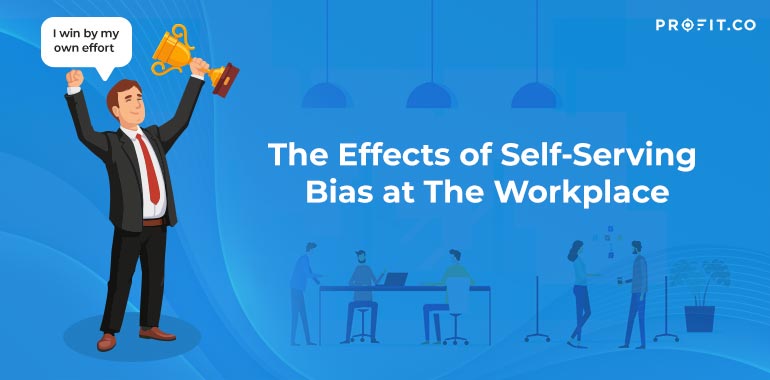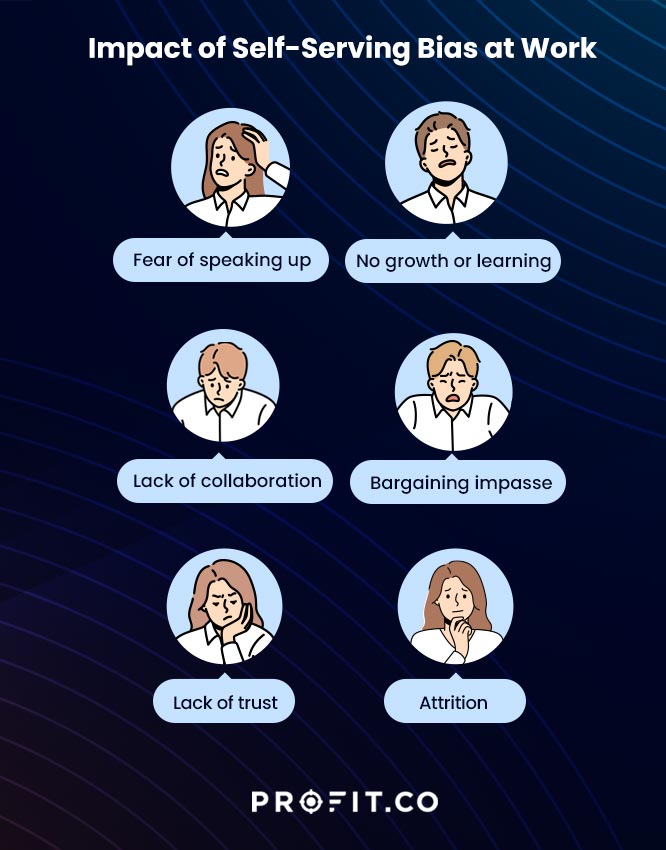Our minds look for the meaning behind every good and bad thing that happens in life. We prefer positive events and results but rarely find fault in ourselves when things go wrong. Self-serving bias is when we take credit for the good and blame others for the bad.
How does this bias affect our personal and work life, and how can we avoid it? Read this guide to find out.
What Is Self-Serving Bias?
Self-serving bias is a mental shortcut that helps us process positive and adverse events. It happens when we credit ourselves for success but blame others or external factors for failure.
For example, if you score an A+, you say it’s because you’re naturally intelligent. But if you score a D-, you blame the teacher, the subject, the class, the school, or even bad luck. You don’t admit that you didn’t study for the test. This thinking pattern is widespread and influences our decision-making process and interpersonal relationships.
Note: The self-serving bias only applies when processing our behavior, not judging others. It skewed our thoughts about our actions and expected outcomes, claiming that negative results are beyond our control.
The trouble with most of us is that we would rather be ruined by praise than saved by criticism.
What Causes Self-Serving Bias?
The self-serving bias occurs for four main reasons:
- We Want to Preserve or Improve Our Self-Esteem
When we attribute good things to our characteristics, we look good to ourselves and others. But when we attribute bad outcomes to external circumstances, we spare our self-esteem from all criticism and retain our good image and standing among our peers.
- We Value People’s Opinions
Whether we admit it or not, our self-image depends on how others perceive us. The self-serving bias enables us to share only positive information about ourselves to match others’ expectations.
- We’re Naturally Optimistic
Nobody sets out to fail, so negative outcomes shock and surprise us. Our minds are, therefore, quick to blame external factors rather than admit a mistake in our thinking or judgment.
- We Live in A Competitive Culture
In a competitive environment, we tie our self-worth to performance. Western cultures that value individualism are more prone to self-serving bias than Eastern cultures that attribute success to fate, luck, or chance.
Examples of Self-Serving Bias
The following are real-life examples of self-serving bias:
- Winning and Losing in Sports
Whether you play casually or professionally, sportsmanship involves gracefully accepting good and poor performance. In most cases, the winners attribute their success to training hard, great teamwork, and a can-do attitude. But if they lose, they may point to anything but their lack of fitness. The fault lies with the coach, referees, weather conditions, distractions from the sidelines, faulty gear, or other external reasons.
- Classroom Performance
An example of self-serving bias mentioned earlier, is students and test scores. However, teachers also exhibit a self-serving bias when assessing their class outcomes.
Failing students affect the teacher’s image, esteem, and job security, so they’re more likely to blame the students for poor performance rather than assess their teaching skills. Conversely, teachers may attribute good class performance more to their personalities or exceptional teaching abilities than to the students’ intelligence.
- Employment
Just like sports, we tie our self-esteem to our career choices. So, if you get hired for a new job, you attribute this positive outcome to your talent, people skills, and exceptional resume. But suppose you fail the interview or get no response from job applications. In that case, you blame the interviewers for discrimination or errors in their judgment.
Employees who get fired rarely admit wrongdoing. Entrepreneurs also succumb to self-serving bias. If the business is successful, it’s because of excellent leadership and vision; if not, they may blame market forces or bad employees.
- Vehicle Accidents
Research indicates that 75% of people in car accidents blame the other driver, even when they’re at fault. These situations promote self-serving bias because auto accident attorneys and insurance commercials make blaming others the default reaction.
Book a free demo with our team to learn more about how OKR software can optimize your organization’s performance!
Self-Serving Bias at The Workplace
A workplace is an excellent example of self-serving bias. It’s a highly competitive environment that brings different personalities together, and there’s often no room for failure.
Think of a colleague arriving late to work and blaming traffic–we rarely admit to oversleeping. The self-serving bias will always come up as we interact with managers, colleagues, and customers. Here are some scenarios to demonstrate self-serving bias at work:
- Team Performance Reports
A manager faces intense pressure when presenting the team’s performance to top leadership. Self-serving bias kicks in when the manager emphasizes the team’s wins, barely mentioning the shortcomings, then blames any poor performance on team members. Managers use self-serving bias to avoid taking responsibility for their team’s failures.
- Financial Reports
Fiscal responsibility is always challenging for companies, especially if tough choices like layoffs are necessary. Since businesses don’t set out to fail, they report poor financial performance but blame market forces rather than poor strategy or inadequate leadership.
- Negative Criticism
Employee performance reviews typically reveal both positive and negative attributes. Employees will often blame colleagues for their poor performance when a supervisor or HR manager constructively criticizes them. This bias traps an organization in a toxic work culture where nobody owns their roles.
- Project Feedback
Project managers often get overwhelmed by new, ambitious projects, resulting in self-serving bias to explain their shortcomings. For example, suppose a manager needs approvals or guidance but needs to know which lines of communication to follow. In that case, the manager blames the organization for poor communication and lack of collaboration rather than risk looking incompetent.
- Employee Training
Even though training opportunities potentially improve performance, some toxic workplaces use training as punishment. Self-serving bias influences managers to offer training programs for underperforming teams rather than the managers enhancing their leadership style.
How Does Self-Serving Bias Impact an Organization?
Self-serving bias has several adverse effects on workplace culture, which include:
- Fear of Speaking Up
If managers respond to criticism with a self-serving bias, team members may feel scared of giving their honest opinions or feedback at work. They fear being blamed for shortcomings or losing face among their peers.
- Lack of Trust
Self-serving bias leads to an environment where nobody takes responsibility for harmful actions, meaning that team members with valid concerns about their workplace feel stranded or trapped. This leads to high turnover or even strike action to force management to admit their shortcomings.
- No Growth or Learning
People see no need to adjust their attitudes when it’s always someone else’s fault. Employees could blame low productivity in the workplace on lousy leadership, lack of budget, or outdated technology, and employees, therefore, become lazy and unmotivated at work.
- Lack of Collaboration
Projects that require teamwork often fail if the team defaults to self-serving bias. Nobody is held accountable for poor results, and nobody will risk taking the blame for it, either. Team members would much rather work on solo projects than take the fall for the group.
- Bargaining Impasse
Suppose two or more parties in a dispute refuse to take the blame for a negative outcome or all take credit for a positive result. This scenario often leads to frustration during negotiations, where one party may walk out or refuse settlement. In this case, self-serving bias can escalate the situation or cause unfair punishment.
Why Is Self-Serving Bias Not Good?
When we put our interests over others when making decisions, we color our perspectives and avoid constructive criticism. Self-serving bias, therefore, influences our ability to learn from our experiences. This bias can lead to the following:
- No personal growth: If we cannot accept our faults, we cannot improve ourselves.
- Poor relationships: Constantly blaming others often adds unnecessary stress to our interactions.
- Resistance to change: Self-serving bias can make us cling to our skewed thinking even when we need to adapt to new circumstances
- Poor collaboration: If leaders have self-serving bias, they make decisions that benefit themselves and not their team.
- Rumination: The effects of failure don’t stop after we preserve our esteem by blaming external causes. If the mishap was our fault, we could dwell on it for too long internally without taking any external problem-solving actions. This rumination increases stress, anxiety, and depression.
- Imposter syndrome: In some cases, people who habitually demonstrate self-serving bias may deny responsibility for both adverse and positive outcomes. This internal conflict can cause us to write off our merits when we deserve a reward.
How Can We Overcome Self-Serving Bias?
The first step to overcoming self-serving bias is acknowledging it exists in the first place. As you become more mindful of biases in everyday life, you can catch and correct their influence on your decisions. Other ways to mitigate self-serving bias include
- Be Less Defensive
When we’re kind to ourselves and accept our flawed humanity, we can better acknowledge our shortcomings and commit to improvement. Failure is an uncomfortable part of life, but it’s also a teacher by helping us learn and grow from that experience. This compassion also helps us understand others’ reactions to failure and why they choose self-serving bias to protect their self-esteem.
- Assess Events Accurately
As mentioned at the start, self-serving bias attributes positive outcomes to ourselves and adverse consequences to external factors. In reality, events are rarely black-and-white, so it’s essential to evaluate them accurately.
Success and failure have numerous variables that our minds overlook, using self-serving and confirmation bias as shortcuts. An objective and balanced approach can help assess our actions and give credit where it’s due.
- Encourage Feedback
Managers can encourage employees by using appropriate performance review phrases to open communication channels in the workplace besides speaking one-on-one. For example, you can use anonymous feedback tools to give your team a sense of safety, resolve conflicts, and implement changes to improve performance. These digital tools protect the team’s privacy when answering questionnaires or commenting on virtual meetings.
- Lead by Example
Employees look up to management for guidance and inspiration. If top management consistently demonstrates self-serving bias, the rest of the team follows suit. To overcome this, leaders should acknowledge their shortcomings and become more accountable, creating psychological safety for employees to speak up and suggest improvements.
- Encourage Innovation
In an environment where self-serving bias is common, people gradually stop being creative and taking risks. That’s because every risk has a chance of failure. We can overcome this example of self-serving bias by rewarding creativity and using failure as a learning opportunity.
Conclusion
Self-serving bias is a natural tendency in humans to protect our self-esteem and image. Unfortunately, blaming external factors for our shortcomings denies us numerous opportunities for reflection and growth. Self-serving bias can also contribute to a toxic workplace culture. Employees lose motivation when managers deny responsibility for poor performance or when colleagues blame management and each other for their weaknesses. Finally, we can overcome the self-serving bias by evaluating every outcome objectively and transforming every failure into a learning opportunity.
You can get started on Profit.co completely free today to learn how OKRs can help optimize your organization’s performance.





